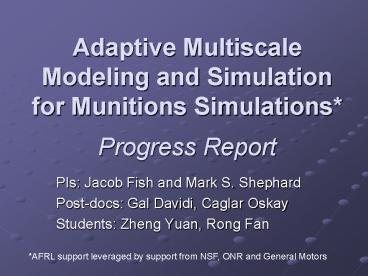Adaptive Multiscale Modeling and Simulation for Munitions Simulations* Progress Report - PowerPoint PPT Presentation
1 / 14
Title:
Adaptive Multiscale Modeling and Simulation for Munitions Simulations* Progress Report
Description:
Adaptive Multiscale Modeling and Simulation for Munitions Simulations* Progress Report PIs: Jacob Fish and Mark S. Shephard Post-docs: Gal Davidi, Caglar Oskay – PowerPoint PPT presentation
Number of Views:89
Avg rating:3.0/5.0
Title: Adaptive Multiscale Modeling and Simulation for Munitions Simulations* Progress Report
1
Adaptive Multiscale Modeling and Simulation for
Munitions SimulationsProgress Report
- PIs Jacob Fish and Mark S. Shephard
- Post-docs Gal Davidi, Caglar Oskay
- Students Zheng Yuan, Rong Fan
AFRL support leveraged by support from NSF, ONR
and General Motors
2
Roadmap of Developments
- Assessment of commercial code capabilities
- Mesh sensitivity studies (Gal Davidi)
- Validation studies (Rong Fan)
- Fragmentation capabilities for metals
- Homogenization based approach (Gal Davidi)
- Integration of homogenization in ABAQUS (Zhen
Yuan) - PUM based (Zhen Yuan and Rong Fan)
3
Roadmap of Developments (cont)
- Fragmentation capabilities for composites
- Reduced order methodology (Oskay)
- Validation studies (Oskay)
- Integration in ABAQUS
- Multiscale Enrichment based PUM
- Applications
4
Fragmentation in MetalsExperimental setup
The experimental parameters considered Steel
target plate DH36 steel 3/16 inch thick 6 inch
diameter Impact velocity In the range
between 920 ft/sec. Backing material
Polyurea 0.215 inch Impactor non-deformable
5
Experiment vs ABAQUS simulation (without backing)
Mises stress (without backing)
Equivalent plastic strain (without backing)
6
Experiment vs SimulationDH36
7
Drawbacks of commercial software
- Cost of 3D simulations (4 days for 21
layer-model, r-adaptivity) - Mesh dependency of both 3D and shell models
3.00E05
3D models (4-8 layers)
2.50E05
2.00E05
1.50E05
Fine (160)
1.00E05
Coarse (80)
Very Coarse (40)
5.00E04
0.00E00
0
0.00005
0.0001
0.00015
0.0002
0.00025
0.0003
0.00035
0.0004
0.00045
8
Remedy Multiscale Enrichment
- Global (structure) Enrichment
- Enrich the kinematics of the global mesh with
failure characteristic (delamination, shear
banding, fragmentation) characteristic computed
on the local patch - For computational efficiency
- Local (material) Enrichment
- Embed discontinuities (strong or weak) into
material (micromechanical) model - For regularization of failure models
9
Global Enrichment (MEPU)
Better
(Superposition)
(Domain decomposition)
10
Global Enrichment (metals)3D simulations
300
DH36 ERC (3D-21 layers)
250
MEPU
200
Velocity of Impactor (m/s)
150
100
50
0
0
0.0001
0.0002
0.0003
0.0004
Time (s)
11
Local Enrichment (metals)(in progress)
- Calculate discontinuity direction at each Gauss
point - Align the RVE local coordinate system with one of
the axis normal to the localization plane - Develop a 3-point RVE model as follows
Constrained RGB
Gauss point
Constrained periodicity
Shell
master
12
Impact Fragmentation of composites
- Phenomenological
- Advantages
- Fast
- Disadvantages
- Reliability
- Experiments architecture
- dependent
- Direct Homogenization
- Advantages
- Reliability
- Architecture independent Exp.
- Disadvantages
- Computationally formidable
- Eigendeformation-based Reduced Order
Homogenization
13
Validation Tube Crush Experiment
- Experiments by Oak Ridge (Starbuck et al.)
- Impact Velocity 4000 mm/sec
- Microstructure Woven composite
14
Model Validation (composites)



















![???? ?? Multiscale simulation for process development [Ch. 2] in Computational multiscale modeling of fluids and solids by M.O. Steinhauser PowerPoint PPT Presentation](https://s3.amazonaws.com/images.powershow.com/7058493.th0.jpg?_=201508190512)











